Comparative Study of Wind Turbine Placement Methods for Flat Wind Farm Layout Optimization with Irregular Boundary
Abstract
Featured Application
Abstract
1. Introduction
2. Optimization Models
2.1. Wake Model
2.2. Wind Turbine Model and Wind Farm Cost Model
2.3. Wind Condition Model
3. Methodology
3.1. Boundary Handling Methods
3.2. Comparison of Grid and Coordinate Methods
3.3. Objective Function Evaluation Method
4. Results and Discussion
4.1. Comparison of Computational Results
4.2. Comparison of Computational Cost
4.3. Comparison of Optimal Wind Farm Layouts
4.4. Angular Resolution Analysis of Wind Climatology
5. Conclusions
Funding
Acknowledgments
Conflicts of Interest
References
- Lansdorp, B.; Williams, P. The Laddermill-Innovative Wind Energy from High Altitudes in Holland and Australia. Wind Power 2006, 6, 1–14. [Google Scholar]
- Alotto, P.; Guarnieri, M.; Moro, F. Redox flow batteries for the storage of renewable energy: A review. Renew. Sustain. Energy Rev. 2014, 29, 325–335. [Google Scholar] [CrossRef]
- Blaabjerg, F. Future on Power Electronics for Wind Turbine Systems. IEEE J. Emerg. Sel. Top. Power Electron. 2013, 1, 139–152. [Google Scholar] [CrossRef]
- Van der Laan, M.P.; Hansen, K.S.; Sørensen, N.N.; Réthoré, P.-E. Predicting wind farm wake interaction with RANS: An investigation of the Coriolis force. J. Phys. Conf. Ser. 2015, 625, 012026. [Google Scholar] [CrossRef]
- Nikolić, V.; Shamshirband, S.; Petković, D.; Mohammadi, K.; Cojbašić, Ž.; Altameem, T.A.; Gani, A. Wind wake influence estimation on energy production of wind farm by adaptive neuro-fuzzy methodology. Energy 2015, 80, 361–372. [Google Scholar] [CrossRef]
- Shakoor, R.; Hassan, M.Y.; Raheem, A.; Wu, Y.K. Wake effect modeling: A review of wind farm layout optimization using Jensen’s model. Renew. Sustain. Energy Rev. 2016, 58, 1048–1059. [Google Scholar] [CrossRef]
- Mosetti, G.; Poloni, C.; Diviacco, D. Optimization of wind turbine positioning in large wind farms by means of a Genetic algorithm. J. Wind Eng. Ind. Aerodyn. 1994, 51, 105–116. [Google Scholar] [CrossRef]
- Beyer, H.G.; Rüger, T.; Schäfer, G.; Waldl, H.-P. Optimization of Wind Farm Configurations with Variable Number of Turbines. In Proceedings of the European Union Wind Energy Conference, Göteborg, Sweden, 20–24 May 1996; pp. 1073–1076. [Google Scholar]
- Pérez, B.; Mínguez, R.; Guanche, R. Offshore wind farm layout optimization using mathematical programming techniques. Renew. Energy 2013, 53, 389–399. [Google Scholar] [CrossRef]
- Feng, J.; Shen, W.Z. Solving the wind farm layout optimization problem using random search algorithm. Renew. Energy 2015, 78, 182–192. [Google Scholar] [CrossRef]
- Chen, Y.; Li, H.; He, B.; Wang, P.; Jin, K. Multi-objective genetic algorithm based innovative wind farm layout optimization method. Energy Convers. Manag. 2015, 105, 1318–1327. [Google Scholar] [CrossRef]
- Zhang, P.Y.; Romero, D.A.; Beck, J.C.; Amon, C.H. Solving wind farm layout optimization with mixed integer programs and constraint programs. EURO J. Comput. Optim. 2014, 2, 195–219. [Google Scholar] [CrossRef]
- Wang, L.; Tan, A.C.C.; Gu, Y.; Yuan, J. A new constraint handling method for wind farm layout optimization with lands owned by different owners. Renew. Energy 2015, 83, 151–161. [Google Scholar] [CrossRef]
- Wang, L.; Tan, A.C.C.; Cholette, M.E.; Gu, Y. Optimization of wind farm layout with complex land divisions. Renew. Energy 2017, 105, 30–40. [Google Scholar] [CrossRef]
- Kuo, J.Y.J.; Romero, D.A.; Amon, C.H. A mechanistic semi-empirical wake interaction model for wind farm layout optimization. Energy 2015, 93, 2157–2165. [Google Scholar] [CrossRef]
- Shakoor, R.; Hassan, M.Y.; Raheem, A.; Rasheed, N. Wind farm layout optimization using area dimensions and definite point selection techniques. Renew. Energy 2016, 88, 154–163. [Google Scholar] [CrossRef]
- Wang, F.; Liu, D.; Zeng, L. Study on computational grids in placement of wind turbines using genetic algorithm. In Proceedings of the WNWEC 2009—2009 World Non-Grid-Connected Wind Power and Energy Conference, Nanjing, China, 24–26 September 2009; Volume 2, pp. 369–372. [Google Scholar]
- Mittal, A. Optimization of the Layout of Large Wind Farms Using a Genetic Algorithm; Case Western Reserve University: Cleveland, OH, USA, 2010. [Google Scholar]
- Wang, L.; Tan, A.C.C.; Gu, Y. Comparative study on optimizing the wind farm layout using different design methods and cost models. J. Wind Eng. Ind. Aerodyn. 2015, 146, 1–10. [Google Scholar] [CrossRef]
- Engineering Model (OffWindEng). Available online: http://offwind.eu/Help/EngWindSim (accessed on 2 September 2017).
- Jensen, N.O.O. A Note on Wind Generator Interaction; Risø National Laboratory: Roskilde, Denmark, November 1983; ISBN 87-550-0971-9. [Google Scholar]
- Pookpunt, S.; Ongsakul, W. Optimal placement of wind turbines within wind farm using binary particle swarm optimization with time-varying acceleration coefficients. Renew. Energy 2013, 55, 266–276. [Google Scholar] [CrossRef]
- Wang, L.; Cholette, M.E.; Tan, A.C.C.; Gu, Y. A computationally-efficient layout optimization method for real wind farms considering altitude variations. Energy 2017, 132, 147–159. [Google Scholar] [CrossRef]
- Salcedo-Sanz, S.; Gallo-Marazuela, D.; Pastor-Sánchez, A.; Carro-Calvo, L.; Portilla-Figueras, A.; Prieto, L. Evolutionary computation approaches for real offshore wind farm layout: A case study in northern Europe. Expert Syst. Appl. 2013, 40, 6292–6297. [Google Scholar] [CrossRef]
- Kusiak, A.; Song, Z. Design of wind farm layout for maximum wind energy capture. Renew. Energy 2010, 35, 685–694. [Google Scholar] [CrossRef]
- Gebraad, P.; Thomas, J.J.; Ning, A.; Fleming, P.; Katherine, D. Maximization of the annual energy production of wind power plants by optimization of layout and yaw-based wake control. Wind Energy 2017, 20, 96–107. [Google Scholar] [CrossRef]
- DuPont, B.; Cagan, J.; Moriarty, P. An advanced modeling system for optimization of wind farm layout and wind turbine sizing using a multi-level extended pattern search algorithm. Energy 2016, 106, 802–814. [Google Scholar] [CrossRef]
- Abdulrahman, M.; Wood, D. Investigating the Power-COE trade-off for wind farm layout optimization considering commercial turbine selection and hub height variation. Renew. Energy 2017, 102, 267–278. [Google Scholar] [CrossRef]
- Chen, Y. Commercial Wind Farm Layout Design and Optimization; Texas A&M University: College Station, TX, USA, 2013. [Google Scholar]
- Zhang, C.; Hou, G.; Wang, J. A fast algorithm based on the submodular property for optimization of wind turbine positioning. Renew. Energy 2011, 36, 2951–2958. [Google Scholar]
- Mikkelsen, R. Actuator Disc Methods Applied to Wind Turbines; Technical University of Denmark: Lyngby, Denmark, 2003. [Google Scholar]
- Seguro, J.V.; Lambert, T.W. Modern estimation of the parameters of the Weibull wind speed distribution for wind energy analysis. J. Wind Eng. Ind. Aerodyn. 2000, 85, 75–84. [Google Scholar] [CrossRef]
- Feng, J.; Shen, W.Z. Modelling wind for wind farm layout optimization using joint distribution of wind speed and wind direction. Energies 2015, 8, 3075–3092. [Google Scholar] [CrossRef]
- Kirchner-Bossi, N.; Porté-Agel, F. Realistic Wind Farm Layout Optimization through Genetic Algorithms Using a Gaussian Wake Model. Energies 2018, 11, 3268. [Google Scholar] [CrossRef]
- Eroglu, Y.; Seckiner, S.U. Design of wind farm layout using ant colony algorithm. Renew. Energy 2012, 44, 53–62. [Google Scholar] [CrossRef]
- Lind, P.G.; Herráez, I.; Wächter, M.; Peinke, J. Fatigue Load Estimation through a Simple Stochastic Model. Energies 2014, 7, 8279–8293. [Google Scholar] [CrossRef]
- Abdelsalam, A.M.; El-Shorbagy, M.A. Optimization of wind turbines siting in a wind farm using genetic algorithm based local search. Renew. Energy 2018, 123, 748–755. [Google Scholar] [CrossRef]

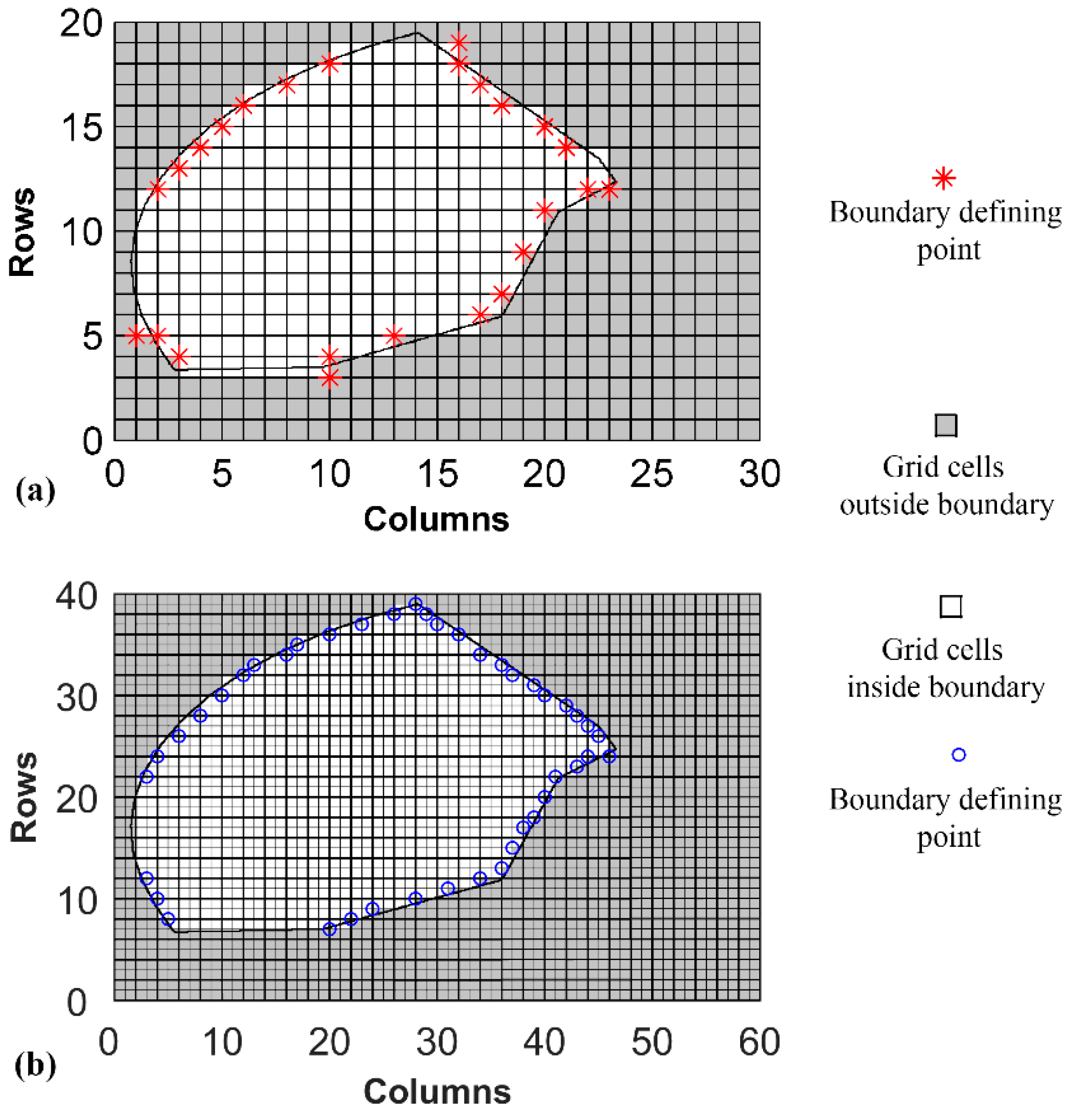
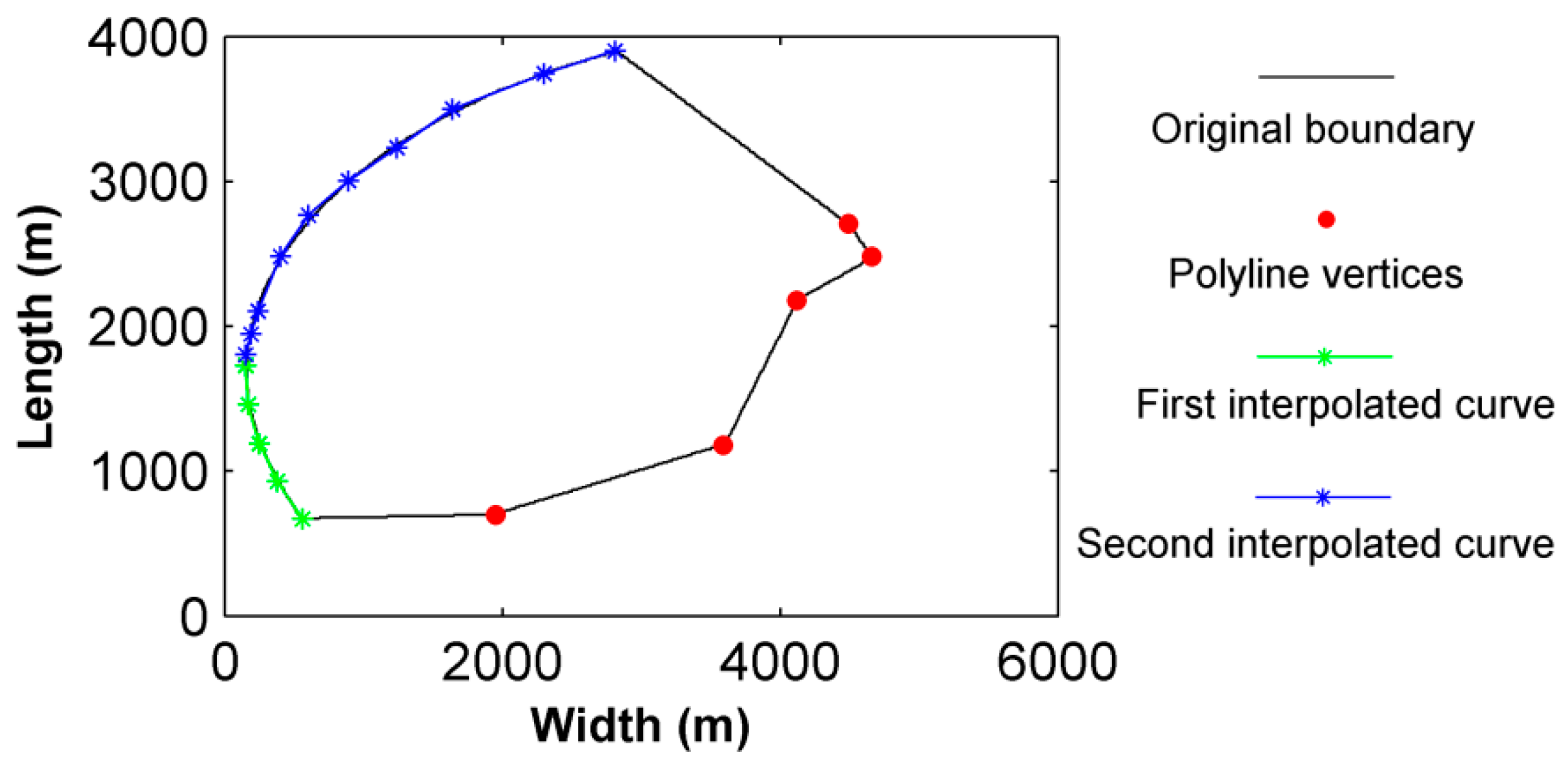

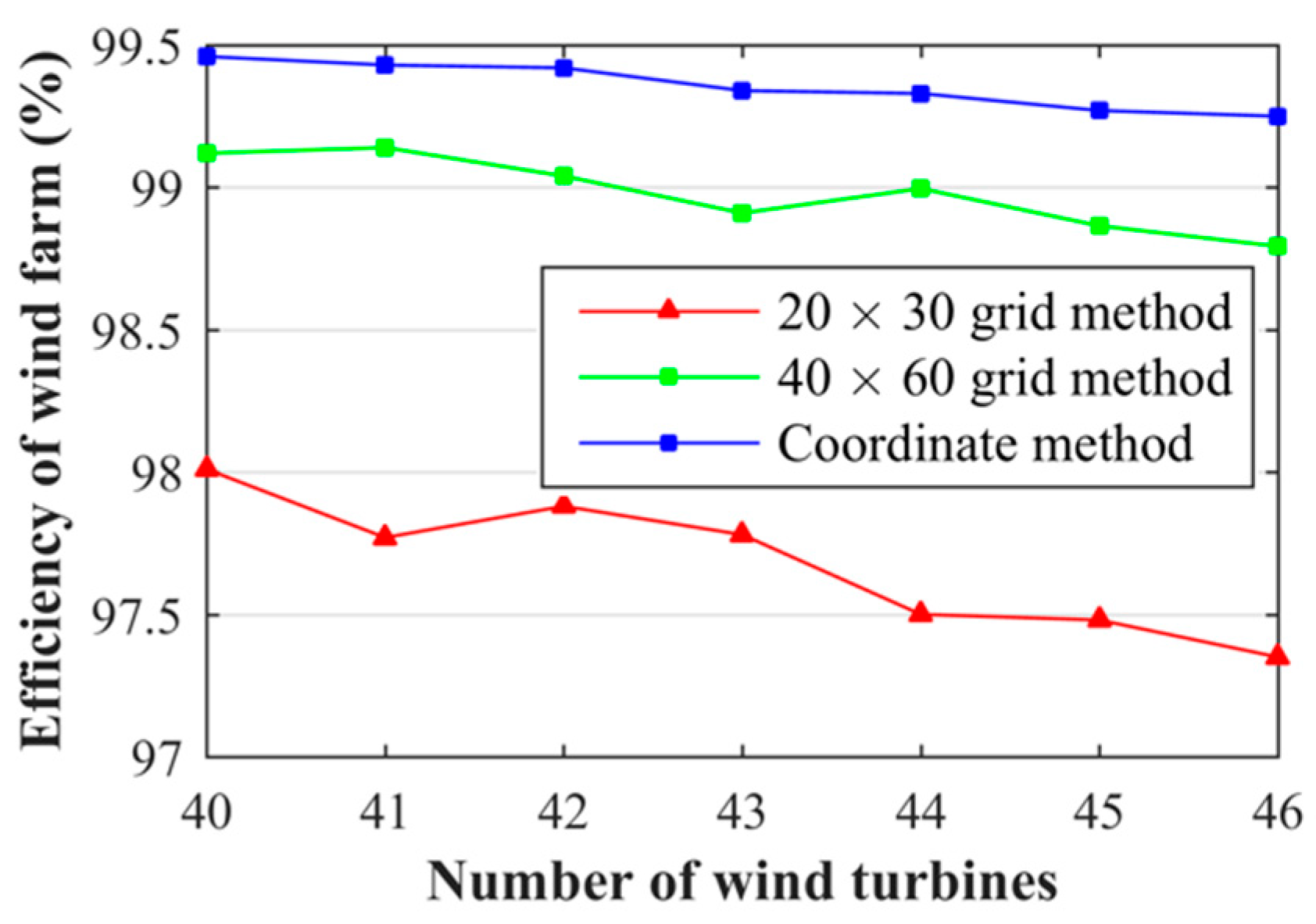
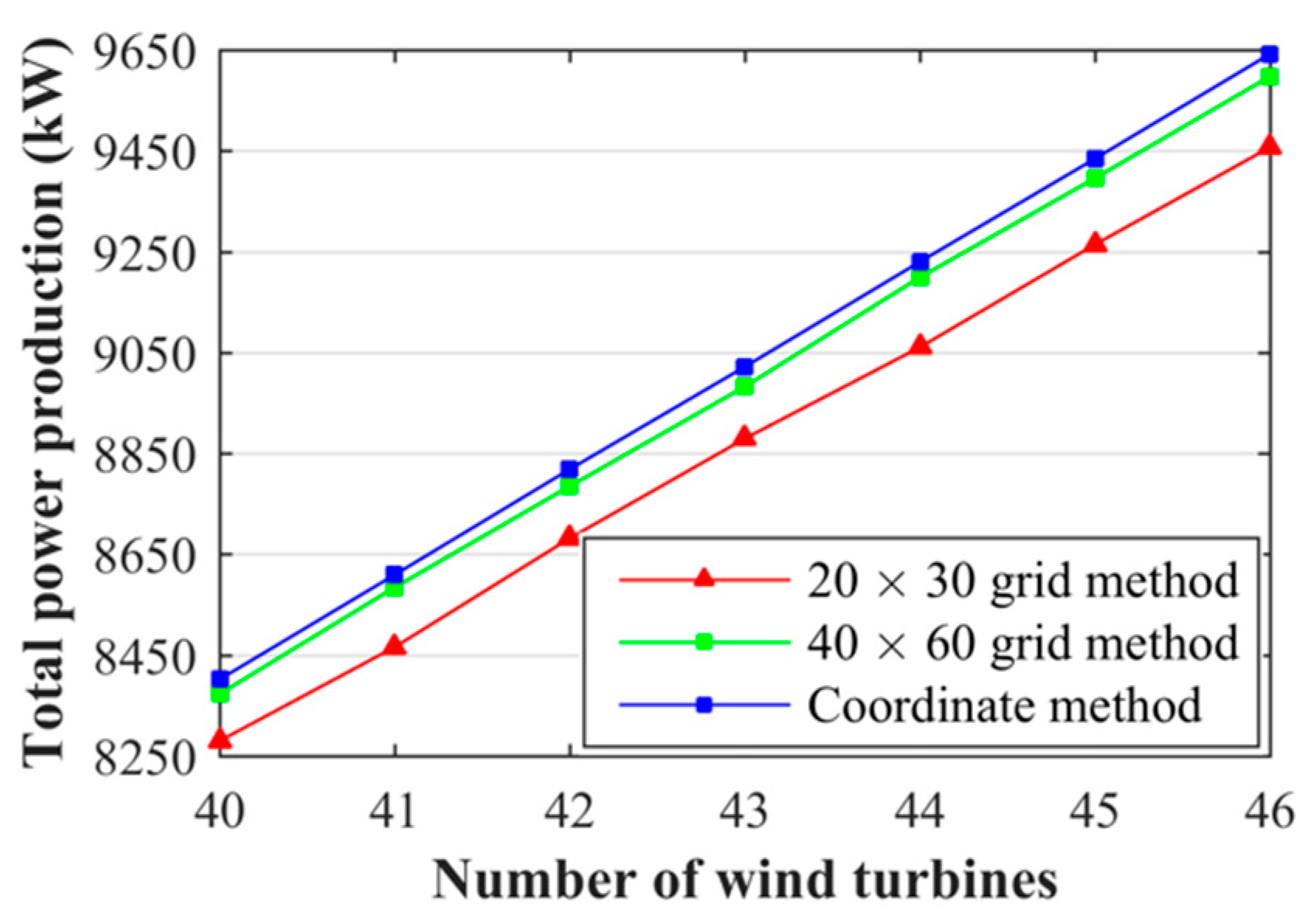
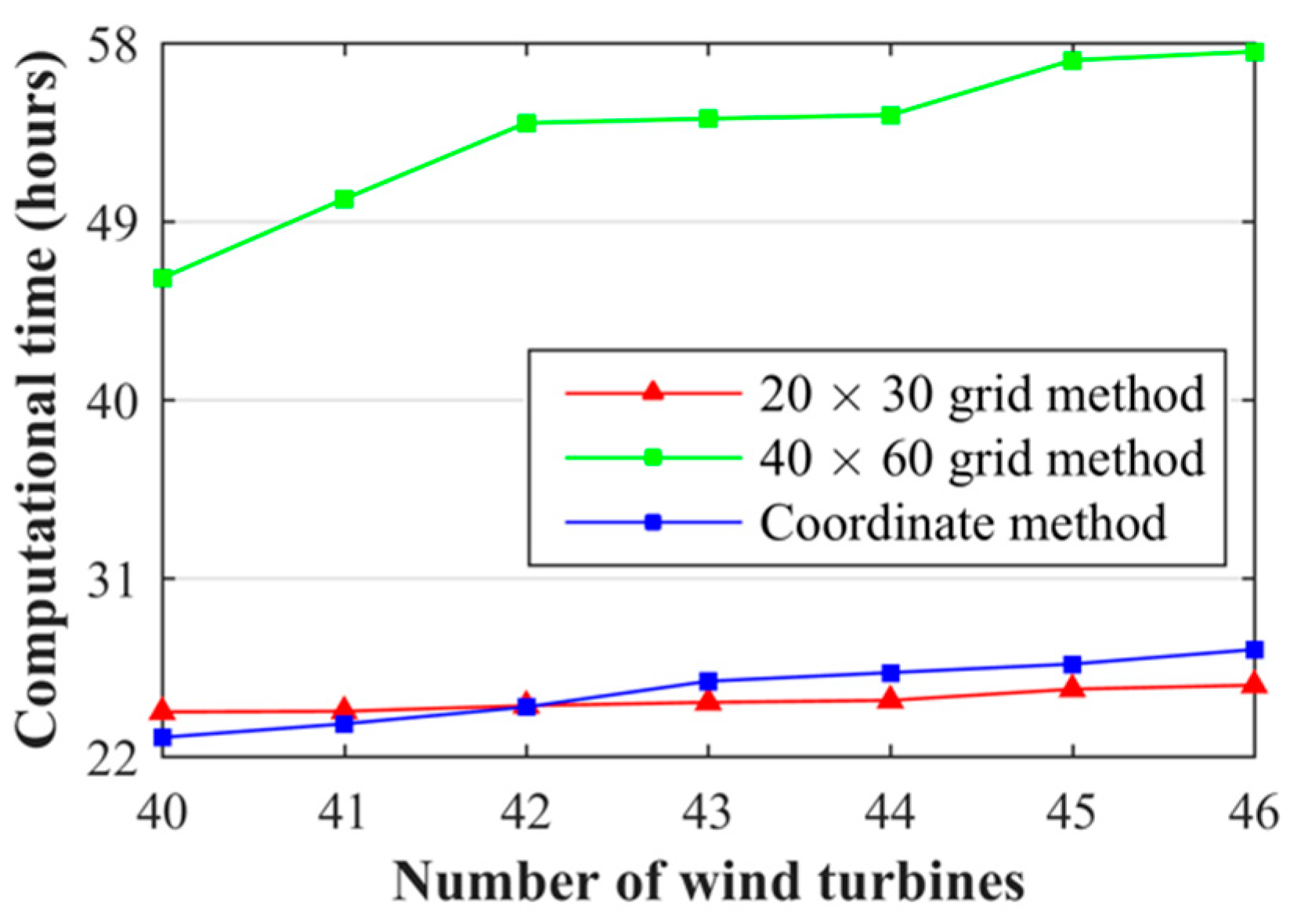


| Parameters | Values |
|---|---|
| Rated power | 1000 kW |
| Rotor diameter | 54 m |
| Hub height | 60 m |
| Cut-in wind speed | 3 m/s |
| Rated wind speed | 15 m/s |
| Cut-out wind speed | 25 m/s |
| Turbine power | P = 0.2963U3 kW |
| Direction | k | c | ω | Direction | k | c | ω |
|---|---|---|---|---|---|---|---|
| 0°~15° | 2 | 9 | 0 | 180°~195° | 2 | 9 | 0.01 |
| 15°~30° | 2 | 9 | 0.01 | 195°~210° | 2 | 9 | 0.01 |
| 30°~45° | 2 | 9 | 0.01 | 210°~225° | 2 | 9 | 0.01 |
| 45°~60° | 2 | 9 | 0.01 | 225°~240° | 2 | 9 | 0.01 |
| 60°~75° | 2 | 9 | 0.01 | 240°~255° | 2 | 9 | 0.01 |
| 75°~90° | 2 | 9 | 0.2 | 255°~270° | 2 | 9 | 0.01 |
| 90°~105° | 2 | 9 | 0.6 | 270°~285° | 2 | 9 | 0.01 |
| 105°~120° | 2 | 9 | 0.01 | 285°~300° | 2 | 9 | 0.01 |
| 120°~135° | 2 | 9 | 0.01 | 300°~315° | 2 | 9 | 0.01 |
| 135°~150° | 2 | 9 | 0.01 | 315°~330° | 2 | 9 | 0.01 |
| 150°~165° | 2 | 9 | 0.01 | 330°~345° | 2 | 9 | 0.01 |
| 165°~180° | 2 | 9 | 0.01 | 345°~0° | 2 | 9 | 0.01 |
| Design Methods | Grid Method (20 × 30 grid) | Grid Method (40 × 60 grid) | Coordinate Method | |
|---|---|---|---|---|
| Parameters | ||||
| Population type | Binary | Binary | Real | |
| Number of variables | 600 | 2400 | 2 N | |
| Population size | 600 | 600 | 600 | |
| Generations | 1 million | 0.5 million | 0.5 million | |
| Number of Turbines | 40 | 41 | 42 | 43 | 44 | 45 | 46 |
|---|---|---|---|---|---|---|---|
| Relative power increase using (40 × 60 grid) | 1.13% | 1.4% | 1.19% | 1.16% | 1.53% | 1.42% | 1.49% |
| Relative power increase using coordinate method | 1.47% | 1.69% | 1.58% | 1.6% | 1.87% | 1.84% | 1.96% |
| Turbine Number | 40 | 41 | 42 | 43 | 44 | 45 | 46 | |
|---|---|---|---|---|---|---|---|---|
| Design Methods | ||||||||
| Grid method (20 × 30 grid) | 8303 | 8484.4 | 8708.2 | 8899.5 | 9089.5 | 9274.2 | 9482.8 | |
| Grid method (40 × 60 grid) | 8316.1 | 8504.9 | 8719.2 | 8924.1 | 9132.9 | 9302.3 | 9528.4 | |
| Coordinate method | 8316.8 | 8534.5 | 8745.3 | 8924.6 | 9155.5 | 9345.6 | 9528.9 | |
© 2019 by the author. Licensee MDPI, Basel, Switzerland. This article is an open access article distributed under the terms and conditions of the Creative Commons Attribution (CC BY) license (http://creativecommons.org/licenses/by/4.0/).
Share and Cite
Wang, L. Comparative Study of Wind Turbine Placement Methods for Flat Wind Farm Layout Optimization with Irregular Boundary. Appl. Sci. 2019, 9, 639. https://doi.org/10.3390/app9040639
Wang L. Comparative Study of Wind Turbine Placement Methods for Flat Wind Farm Layout Optimization with Irregular Boundary. Applied Sciences. 2019; 9(4):639. https://doi.org/10.3390/app9040639
Chicago/Turabian StyleWang, Longyan. 2019. "Comparative Study of Wind Turbine Placement Methods for Flat Wind Farm Layout Optimization with Irregular Boundary" Applied Sciences 9, no. 4: 639. https://doi.org/10.3390/app9040639
APA StyleWang, L. (2019). Comparative Study of Wind Turbine Placement Methods for Flat Wind Farm Layout Optimization with Irregular Boundary. Applied Sciences, 9(4), 639. https://doi.org/10.3390/app9040639




